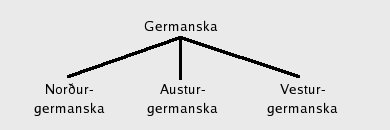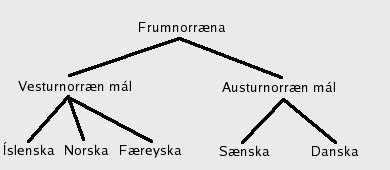
East Germanic is considered to comprise only one language, Gothic, which was spoken by the ancient race of Goths, and is now extinct. Sources about this can be found in Bishop Wulfilas' translation of the bible from the 4th century AD. Germanic languages include English, German, Dutch and Friesian. The oldest North Germanic language is called Old Norse, which was spoken in Scandinavia from about 200 to 800 AD. Most sources of this language are found in runic inscriptions. Old Norse then divided into two branches, which in turn branched:

This explains why Icelandic is closer to Norwegian and Faeroese, than to Swedish and Danish though they all stem from the same root. The settlers brought their language with them when they settled Iceland. Most came from West Norway, but there were also settlers from other regions of Norway. Some came from Denmark and Sweden, if we can rely on ancient sources. The settlers also brought slaves from Ireland. In the very earliest language one can find evidence of Celtic words, though their influence was never great. The language in Iceland developed gradually and diverged from Norwegian, which also developed in its own direction. Through the centuries, Icelandic has changed in a number of ways, both in terms of pronunciation and in the inflections. Many words have also been incorporated from other languages. The creation of new words in the country itself is also continuous, so the language is in a process of steady development. Translated by Paul Richardson. Further answers in English:
- Are portmanteau words frequent in Icelandic? by Guðrún Kvaran
- Is Icelandic the oldest language in Europe? How old is it? by Jón Axel Harðarson
- Why do male last names in Icelandic end with -son instead of -sonur? by Guðrún Kvaran
- Are there rules that say when words in Icelandic should be masculine, feminine and neuter? For a foreigner it is not enough to add an article. by Guðrún Kvaran
- How did the Icelandic language start? by Guðrún Kvaran
- What is the shortest sentence in Icelandic to contain all the letters of the Icelandic alphabet? by Guðrún Kvaran
- How many words are there in Icelandic? by Guðrún Kvaran
- How many words are there in Icelandic for the devil? by Guðrún Kvaran

